| Home Topics Memorials Miscellany Transcripts References Family History Glossary Latest Beeston Blog About us | Site Search |
|
Cinemas in Beeston -
Waller Jeff's life, in fact, embraced a range of interests. While it is not really a Beeston story, those who are interested in reading more of his unusual lifestory can read about him here. One local man in particular took notice of the interest generated by the visit by Waller Jeffs - and acted upon it immediately. Henry Peberdy sold fish and greengroceries from his shop at 115 Queens Road, Beeston but now saw the chance to diversify, starting by showing films at the back of the shop 2 to those willing to pay a few pence and then - in the true entrepreneurial style of the day, going for larger audiences in local halls. His first such venue was at Station Road Schools - which, by the nature of the venue, must have been an occasional rather than a regular showing. Next came a more permanent set-up in the old silk mill building which he opened in the summer of 1907. Named the Cozydrome and later Kozy Kinema, it was accessed down the alleyway which still exists between Greggs and the card shop 3. Patrons paid a few pennies and set on wooden benches to watch a programme of short films, lantern slides, interspersed with intervals when Peberdy, an accomplished violinist, filled in with pieces on various instruments. At first the projector was hand-cranked and oil lamps provided the lighting but, as the enterprise developed, the projector became motorised and gas lighting was introduced which helped maintain its popularity. Finally however, he was to face the onerous demands of the Cinematograph Act of 1909. A number of tragic fires had occurred elsewhere - not surprising, given the volotile combination of the highly flammable nitrate-based film and crude arc lamps in the projectors, used in premises which were often well short of acceptable safety standards. Realising that he could not meet the new high standards, Peberdy had no alternative but to close the Cozy Drome - which he did just before the Act took effect on January 1 1910. Attempts by later developers to involve him were not taken up; it seems that he was the classic individualist. We asked Cyril Peberdy, one of Henry's grandsons to write down his memories of his grandparents. You can read his recollections here.
However, Parker was not the only one who saw the commercial potential of cinema and the interest that it had attracted locally. Thomas James Newbutt Meakin had operated in The City, Beeston as a draper for some years and had prospered and now decided to diversify into cinema locally. After looking around for a suitable venue, he decided that the old Wesleyan chapel building on Chapel Street would be ideal 6, being close in its existing interior layout to what later became the norm - with an upstairs balcony overlooking the stalls seating downstairs. The building was vacant and, in 1912 he submitted a planning application for its conversion as a cinema from a design by local architect J Warburton. Planning permission 7 took a while, with the Licensing Committee 8 expressing concern over exits and the difficulties that would ensue if the audience needed to empty into the very narrow Chapel Street but eventually, after several site visits, it was able to open on 30 October 1912. It was another immediate success and the manager, George Oberbach 9, was able to report packed houses - which clearly had an effect on audiences at the Picture Pavilion. A period of see-sawing, sometimes frenetic, initiatives by the two competing players followed over the next year or so. The Picture Pavilion management soon responded to the competitive threat posed by Meakin's new venture with a decision to rebuild on its High Road site - even though the original structure had only been open for a matter of a few months. This, of course, meant that the existing building could not be used while building was in progress, so a decision was taken to construct a temporary structure - which became known as 'The Tin Trunk' - on land at the top of Regent Street. This was a high-risk stategy but, nevertheless, it went ahead, with the previous building closed its doors on 23 November 1912. As it turned out, the transition was far from trouble free. The Palace Cinema - as we have seen, the 'The Picture Palace' (later to be known simply as 'The Palace') was to be built on the High Road as the replacement for the Beeston Electric Picture Pavilion, the first of the purpose-built cinemas in Beeston and expected to be a real competitor. However, it was of a scale far greater than the previous initiatives and, it seems, Louis Parker had approached local businessmen to support the venture financially. On 21st September 1912, 'The Beeston Picture Palace Ltd' was formed to support this. Although it appears that Parker played a leading part at this stage, it also appears that the venture became dependant on the backing of a particular group of investors, notably local lace manufacturer, Sam Weller Widdowson and Edwin Widdowson (either Sam's brother or nephew) 1; the architect Frederick Ball of Nottingham also had an interest. This appears to have meant that, when it became apparent that Parker's financial estimates had been exceeded and more support from the backers became essential, the Widdowsons took control and Parker moved on. 2
In June 1923, the cinema was sold by its original owners to Joseph Henry Hunt Allsop who, with other members of his family, was to operate the Palace up to its closure nearly 37 eventful years later. Like his father before him, he had worked as a manager for Black's Boot & Shoe Manufacturing Company but now, aged 52, he moved with his wife, two sons and a daughter from Blaby in Leicestershire to Beeston. There, his eldest son, Charles Edward Stanley Allsop, his daughter Florence Phyllis, Charles' twin, and their younger brother Leslie Joseph Henry took various roles in the day-to-day running of the cinema while their father oversaw his investment from their Beeston home at 7 Cavendish Place. Despite a loss of £401 15s 6d that they recorded in the first nine months' of operation and many ups and downs, it was to provide a good living for many years.
In the early 1930s, alongside the universal adoption of sound, many new cinemas of a new generation of cinema design, with attactive modern lines, was beginning to appear which offered an attactive alternative to the early picturehouses - such as the Palace - which were essentially adaptations of the old music halls, complete with gilt and ornamental plasterwork. During this period there was a rapid expansion of these new generation cinemas throughout the Nottingham suburbs and it was only a matter of time before they would appear in Beeston. By 1935, the rumours had become so strong that Joseph Allsop decided to meet the expected competition head-on by modernising and enlarging the Palace. Taking very decisive action, he commissioned Reginald Cooper - one of two architects who had found great success by designing cinemas around Nottingham at this time - to provide the designs 4 and, in the summer of 1935, the Palace closed for about three months while extensive changes were made. (Shown in the photograph, above right, with scaffolding in place) First to go was the ornate facade to be replaced by a modern frontage with a central stainless steel tower with a vertical neon sign. Inside too, there was a complete transformation - the vestibule was now enclosed, upstairs there was a lounge for patrons waiting to enter a new cantilevered balcony, the seating was replaced and extended to 700 and a new, completely re-equipped, projection booth was provided - which included the latest Western Electric Wide Range sound system. The pleasing decor and lighting added to the modern appearance. It was a daring move and the local paper rightly acknowledged it - "Mr Allsop's enterprise shows real business acumen, for it is evident he intends to go forward." 5 For the time being at least, the Palace had re-established itself as Beeston's most modern and best equipped cinema.
War came in September 1939 and after a short period of enforced closure of all public places of entertainment - which was soon rescinded - the Palace stayed open throughout, serving its regular audiences, with the addition of troops from Chilwell Depot and Americans stationed in Wollaton Park. A particular highlight of this period was the epic film "Gone With the Wind" which was shown for two consecutive weeks with one show each night because of its unusually long running time of three hours and forty minutes. 6 In September 1946. with the War finished, Joseph Allsop - then aged 74 - decided to re-organise the ownership structure with a new company "Palace Cinema (Beeston) Limited" taking ownership of the Palace as a going concern and with Joseph's two sons and his daughter, confirmed as permanent directors. The transfer also included ownership of 2-12 Vernon Avenue, properties at the rear of the cinema, which had been acquired in preparation for an intended second phase of redevelopment in 1935 which would have enlarged the auditorium to 1000 seats and incorporate a new stage area. This change had been put on hold when War came and was never carried out. Other changes were put in hand with a complete redecoration taking place in 1947 and the latest Westrex Sound System and Westar projectors were installed. This was a time of much dispute about whether Sunday opening was appropriate. Several local cinemas did decide to open but when, in January 1947, there was a proposal for the Palace to do so, the staff voted against it and their view prevailed. For the time being, cinema-going remained a popular pastime with many families, courting couples and individuals making regular weekly - and sometime more frequent - visits. It is known that the cashier of the day knew her clientele so well that she would have their tickets laid out ready for their arrival. This happy situation began to change from the mid-1950s, as television established itself and audiences began to dwindle. There were innovations that helped - notably Cinemascope, although this required more alterations to widen the proscenium arch and screen and the installation of motorised screen masking and special lenses. But the decline continued relentlesly such that the Palace finally closed its doors on Saturday 20th February 1960, Joseph Henry Hunt Allsop, who with his family had maintained the Palace as one of the last independent cinemas, died just a few weeks later, aged 89. His daughter, Florence Sumner, and eldest son Charles, had died a few years earlier 7. His youngest son Leslie retired to Cornwall where he died in 1972. Once closure was complete, the site was soon cleared and redeveloped as as extension of Burtons supermarket - known as Fine Fare 8 - and is now occupied by a W H Smith book shop and the Dorothy Perkins dress shop. The Palladium Cinema - once the Palace had opened on the High Road in January 1913, it must have been clear to Thomas Meakin that his Palladium cinema on Chapel Street would no longer be able to compete. Something had to be done, and, supported by a group of local businessmen, he acted decisively, first acquiring a suitable site on the High Road, next to the Durham Ox pub, between Stoney Street and Derby Street 1 in July 1913 and had plans ready, approved and under way, ready for an opening which was expected towards the end of that year. In the event, this ambitious timetable was not quite met and there was an unfortunate gap between the Chapel Street closing in October and the grand opening of the new cinema - which continued the Palladium name - on 31 January 1914.
The local paper had a full report on the opening proceedings - a special matinee was attended by directors, shareholders and local worthies, tea was served in the circle and lounge and Fred Shepherd's orchestra provided a special programme of music for the occasion.
Everyone expressed delight at the facilities available.
So, who were Meakin's partners in this venture? It is clear from the account of those attending that he had several co-directors and, it seems, several local businessmen had invested in the company - Palladium (Beeston, Notts) Ltd. The newspaper account only gives initials but it seems that, besides Meakin, the Directors were George William Jacklin, a lace warehouseman who lived in West Bridgford (Chairman), Horace John Winkley, Chartered Accountant, also from West Bridgford, Joseph Baker Anderson, of Queens Road, Beeston, solicitor and John Treece, owner of Shaftesbury Laundry locally. Fred Ball Ludlow, of Lenton, appears to have been the Company Secretary. Other attendees were probably amongst those who invested 7 - William Thums, a well-known Beeston butcher and who had a shop across the road at 72 High Road, George William Brough, a local house builder who also lived on the High Road, Joseph Anderson, then retired as an ironmonger and living on Meadow Road, Beeston and possibly his brother, John Roger Anderson, a well known local figure also a former ironmonger, then of private means living on Grove Street. The Palladium had got off to a good start and, under a series of managers - first William Sergeant Goy, Alexander Jefferies from 1915 and, from 1921, George Collins 8 - it shared the popularity for the medium with the Palace to serve the people of Beeston for over 20 years. In the early days - up to the late 1920s, it used its large stage area - which only the Palladium had at that time - to include live shows, including burlesque, comedy and vocalists. In July 1927, Thomas Meakin sold The Palladium to Nottingham optician, Ezekial Charles Shapeero, to add to the 25 cinemas he had already acquired, from Northampton in the south Midlands to Oldham in the north - including several in Nottingham and two in Long Eaton 9. The new owners made an immediate decision to modernise and, during a week's closure at the end of August that year, the cinema was decorated, new seats and screen were fitted and new 'flicker-free' projectors installed. The cinema re-opened on Monday 5th September with a specially attractive programme and a burst of publicity. The next year - 1928 - however, saw the death of E C Shapeero, aged only 48, and control passed to his 24 year-old son, Aaron Huish Shapeero. This ownership transition came at a time of great change in the cinema industry. In October 1927, the Jazz Singer, staring Al Jolson had been released and this had alerted the industry and its patrons to the "Talkie". It premiered in London in September 1928. Althought the big film studies were initially less than enthusiastic - thinking perhaps of their vast stocks of unreleased silent films - the momentum became unstoppable and, as it turned out, the change was to become their salvation in the difficult financial times they had faced. This first talkie used the Vitaphone, sound-on-disc system. Although this was soon to be elipsed by the Photophone sound-on-film system, the transition needed to be catered for, while films using either or both systems were in circulation - not least by the Palladium where the decision to invest in Movies was taken in early 1930. With this in mind, the Palladium adopted the BTH Sound System which provided for both the on-disk and the on-film technologies. 9 In doing so, it beat its rival - The Palace - by a matter of a week or so, with the first Talkie to be shown in Beeston - opening with "Love At First Sight" in 17 November 1930. This revolution for the cinema-goer was proudly emblazened in the stonework on the corner of the Palladium facade - lettering that survived until its eventual closure ! By the mid-thirties it became apparent that a new phase of cinema building was happening and this was very apparent in Nottingham and its suburbs where some of the best in the country were to be built. There were rumours of new cinemas in Beeston - which, as we will see, became a reality - and both the Palace and the Palladium needed to reconsider its position if they were going to compete and, indeed, survive, As we have seen, the Palace was rebuilt in 1935 and two new modern cinemas were soon to arrive, which left the Palladium in a vulnerable position - having gone from being the best designed in Beeston to being the least attractive in only a few years. Faced with this threat, a bold response was decided upon. Management decided to build a new cinema - The Embassy - on a scale which would totally eclipse the competition. This project, described below, was to be thwarted by events and was never completed so the Palladium was left to continue as best it could. During the War years there was nothing that could be done, other than to make the most of what was available and to respond to the needs of the day. After a brief period of closure that was imposed on all public places of entertainment, films continued to be shown and, as well, the Palladium's stage facilities were used by both the Red Cross and St Johns Ambulance for concerts to raise funds for the war effort. In 1945, Aaron Shapeero - aged only 40 - died and the company passed to his younger brothers, Cyril and Isadore Shapeero. After the war, this new management decided not to continue with the Embassy project and for a time, they looked at ways in which the Palladium could be improved. The old interior was looking distinctly sad with a golden brown tone, the result of a nicotine coating caused by years of smoking in the audience - and the projectors and sound equipment were dated. As a result, in 1948/49, plans were put together for a major revamp but were not, in the event, carried through. No doubt, management felt that the substantial investment that would have been required could not be justified in the face of declining audiences in cinemas generally - and it could well have been difficult to carry out the changes given the scarcity of resources and restrictions on their use in the post-war period. So, for the being, the Palladium continued, little changed, and made the most of its biggest remaining asset - its stage. Ericssons' Dramatic Society presented its annual pantomime there at Christmas 1949, when 'Aladdin' was played to packed and enthusiastic audiences - many keen to see their workmates in an unfamiliar role. During this period too, the manager was Phillip Tussaud-Birt 10 who also involved himself in the annual Beeston Carnival, for several years a popular feature of post-war Beeston. As a result, he was able to arrange for the Carnival Queen to make a guest appearance on the stage and once managed to arrange for 'Lady Godiva' to parade through the streets on horseback ! But the decline continued, with the old audiences turning to television more and more, so that continued operation was no longer the best option. On 18 April 1959, the Palladium became the first of the real cinemas to close in Beeston. The old building was soon demolished and made way for a grocery store. Nowadays, it is the site of Iceland and few under the age of fifty are aware of its glory days as the site of what was once Beeston's most luxurious cinema. The Astoria Cinema - When this stylish new building appeared on the scene in 1936 it was the first of a new generation of cinemas to be be built in Beeston. Built for Herbert Elton's Eskay Cinemas Ltd 1, it was designed by A J Thraves with W & J Simmonds as the main building contractor. Thraves was one of two local architects - the other being R W Cooper - who between them had dominated cinema design in the Nottingham area during the 1930s. Situated on the corner of Boundary Road, Beeston and Derby Road, against the City Boudary at the rear, it was well located to draw audiences from both the Beeston Fields and Lenton Abbey Estates 2.
To view a gallery of pictures of the Astoria, click on the picture on the left or here
In 1949, the Astoria was sold to the Essoldo Group, then one of the largest cinema chains in the country, and, in August 1952 it was renamed The Essoldo. It was during this period of Essoldo management that the cinema industry faced both the challenges and opportunities presented by the technological changes that occurred in the 1950s. In particular. Cinemascope was to add interest and new dimensions for the patrons but was sometimes a challenge because of limitations in the cinemas. This proved particularly the case in 1955 at the Essoldo, where the screen could not be widened because of the position of the exits and ornamental features on each side of the proscenium. Since the screen could not be wider, the height needed to be smaller to accommodate the wide screen effect - hardly ideal ! However, it was at this time that the projection room was re-equiped and otherwise the patrons' viewing experience became noticably enhanced. As we have seen, the effects of falling audiences saw the closure of both the older Beeston cinemas, the Palace and the Palladium, by 1960 and there followed an extended period in which Essoldo fought to find a formula that would be attractive to audiences. In April 1970, the cinema was closed for renovation and re-opened as New Essoldo with the balcony closed and new luxury seating and extra space between the rows - but with the seating capacity reduced to 450. But attendences continued to decline and, in early 1972, the Essoldo group was taken over by the Classic Group to add to its existing chain of 200 cinemas. Innovation continued under the new management, trying many ideas in an attempt to stimulate interest - including late night and all night shows and 'free' refreshments. While some of the ideas had shown promise initially, the overall decline of the industry finally caught up with the Essoldo and it showed its last film on the 11th October 1975. There followed a period in which the building was put to other use - first as a bingo hall, renamed as the Vogue Bingo & Social Club, then converted to a skateboard rink and finally as a snooker hall. In 1996, it finally closed its doors, was demolished in December of that year and then redeveloped as office accommodation. The Majestic Cinema - On 1st September 1938, the Majestic cinema was opened in Beeston with the usual blaze of publicity. This brought the total cinemas in Beeston at that time to four and, as it turned out, this was to be the last cinema to be opened in the town - but, as we will see, this was very nearly not the case.
Birmingham architect, Ernest S Roberts, had provided an impressive design - proudly claimed by the advertising as 'the last word' and 'a veritable landmark' - with a corner entrance with a tiled canopy in light green and a 73ft tower, with similar tiling, carrying the name 'Majestic' in large neon letters. The Queens Road frontage, which corresponded to the depth of the auditorium, featured four decorative brick panels, while the Station Road frontage had large windows to the upstairs lounge. A 'spacious' car park was available. The interior had a sumptuous look - with bright blue Wilton carpet, delicate pink stage curtains and heavy window curtains tied back with sashes. There was seating for 1200 patrons.
The Majestic, of course, had only a year of operation before it, like all other places of entertainment were first closed down and then quickly re-opened and, like the other cinemas, provided much needed entertainment to the local population and to service man and women throughout the hostilities. Cinemas continued to cheer the population throughout the drab post-war years but in Beeston - at the Majestic in particular - hope of improvement in everyday life had a severe jolt during the severe winter of 1947. In March 1947, flood waters swamped the lower parts of Beeston, sweeping along Queens Road and up Station Road as far as Bostocks (now the Conservative Club). The Majestic was cut off and flood waters entered the stalls but, happily, damage was contained. In 1950 the stage facilities at the Majestic were used for first time for a live show. when Ericsson Dramatic Society moved its annual pantamime there, from the Palladium, where it had previously appeared. Its production of "Aladdin", with Jean Jarvis, Joan Hudson and George Booth playing the lead parts, was followed in 1951 by "Robinson Crusoe" at the same venue, with Joan Hudson and George Booth again playing the lead parts. These annual productions were extremely popular and were enthusiatically supported at the various venues, including the company's canteen where later productions were shown. In the 1950s, the Majestic installed Cinemascope and updated its projection equipment to keep the interest of audiences. In 1952,like the Astoria, it was taken over by the Essoldo Group and, also like the Astoria, adopted the Essoldo name - so that, for a time there was two cinemas of the name in Beeston - although the ex-Astoria was known as the Essoldo, Lenton Abbey. There followed, as elsewhere, a period of declining audiences which eventually resulting in its conversion to a Bingo Hall. The building was finally demolished in June 1988 and is now the site of a Co-operative neighbourhood supermarket. The Embassy Cinema - by 1938, the Palladium had found itself in an difficult position. The previous three years had seen a rebuilt Palace and two new-generation cinemas - the Astoria and the Majestic - appearing in Beeston. From being the best designed cinema in Beeston, the Palladium had become the least attractive. Bold measures were called for and management proposed just that by deciding to build a new super cinema in the heart of Beeston. The site chosen, opening onto the Square, where the Derbyshire Building Society and the right-hand half of Barclays Bank is now located, then the site of the old Post Office and extending to the rear into land associated with the Foster residence, now part of Foster Avenue carpark. 1. Plans dated February 1939, produced by Nottingham architect William Newman, showed a cinema complex on a grand scale 2. They showed a vestibule and paybox area fronting on to The Square, with small lock-up shops either side, and a large waiting hall extending to the depth of the adjacent buildings. Above this section, a restaurant/ballroom (Café Dansant) would overlook The Square. In the land to the rear, the building extended to its full width with a foyer and auditorium seating 1200. Overall it was 200 feet from front to back, with a maximum width of 82 feet and a frontage onto The Square of 44 feet. Building commenced almost immediately but as the year progressed, talk of war gathered momentum and, in response, there was even a staff air-raid shelter proposed underneath the stage area. In September 1939, with the outbreak of war, building work came to an abrupt halt and was never resumed. The site remained behind a hoarding which faced The Square, with exposed foundations, often water-filled, in the area to the rear until its gradual development into the car park we see today - with the occasional foundation feature lingering for many years - and the building of bank premises in the frontage in the late 1960s. If the Embassy had been finished, it would have presumable meant the closure of the Palladium - which it was designed to replace - and would probably have had a profound effect to the nearby Palace. As it turned out, Beeston continued with its existing four cinemas for another two decades and with two of then lingering on for a little longer - and the Embassy foundations now buried beneath Foster Avenue carpark. As the Embassy was not finished, perhaps its story is best told as the story of its site. Click the link to view a gallery of photographs which illustrates this. or Return to Top of This Page Notes on the Early Beeston Cinemas The author gratefully acknowledges the guidance and advice received from Leslie Allsop and, with his kind permission, has drawn on "Full House" Mr Allsop's booklet about Beeston cinemas (Undated, but written about 1996 to commemorate 100 years of cinema). Both the author and Leslie Allsop, acknowledge the excellent series of articles on Beeston cinemas, written by Rick Wilde, an authority on Nottingham area cinemas. These appeared in the Beeston Gazette & Echo in 1979. or Return to Top of This Page © David Hallam - 2010 |
|
||||||||||||||
|
|
||||||||||||||||
 The Early Cinemas - it is believed that the first occasion on which Beeston residents experienced moving pictures was during a visit, in the early years of the first decade of
the 20th century, when Waller Jeffs came to town with his travelling show, presented in a large tent - in a field, it is generally believed, somewhere near the top of Regent Street. Jeffs had already taken Birmingham by storm when, in
1901, he set up there in the Curzen Hall. His shows contained a mixture of everything - bands, light opera, dramatic lighting and sound, novelty acts and a real novelty for the time - film. Soon the performances
were pulling in large audiences - sometimes of as many as 3000. His status as a top showman was soon establised and he was to build on this by taking his show on the road. It is quite possible that his itinery would
have taken in the annual Goose Fair in Nottingham and it is probable that it was then that he visited the suburbs of the City - including Beeston. For most of those who paid the admission fee to the show, it would
have been the first time that they had experienced movie films - and Jeffs knew how to attract these first-timers. Often using short films made by Mitchell & Kenyon - early producers of local newsreels
The Early Cinemas - it is believed that the first occasion on which Beeston residents experienced moving pictures was during a visit, in the early years of the first decade of
the 20th century, when Waller Jeffs came to town with his travelling show, presented in a large tent - in a field, it is generally believed, somewhere near the top of Regent Street. Jeffs had already taken Birmingham by storm when, in
1901, he set up there in the Curzen Hall. His shows contained a mixture of everything - bands, light opera, dramatic lighting and sound, novelty acts and a real novelty for the time - film. Soon the performances
were pulling in large audiences - sometimes of as many as 3000. His status as a top showman was soon establised and he was to build on this by taking his show on the road. It is quite possible that his itinery would
have taken in the annual Goose Fair in Nottingham and it is probable that it was then that he visited the suburbs of the City - including Beeston. For most of those who paid the admission fee to the show, it would
have been the first time that they had experienced movie films - and Jeffs knew how to attract these first-timers. Often using short films made by Mitchell & Kenyon - early producers of local newsreels
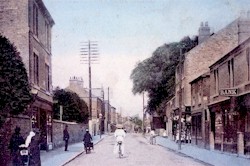 Beeston was now without a cinema of any kind but it was not long before two more of these early initiatives emerged - and resulted in intense rivalry and, as it turned out, some apparently expensive miscalculations. First out of the block was
a venture by one Louis (or possibly John) Parker
Beeston was now without a cinema of any kind but it was not long before two more of these early initiatives emerged - and resulted in intense rivalry and, as it turned out, some apparently expensive miscalculations. First out of the block was
a venture by one Louis (or possibly John) Parker

 In its early days, the Palace, like cinemas up and down the land - including the Beeston cinemas - showed silent films accompanied by a piano and a small orchestra that improvised the mood of the music to suit the unfolding story line of the film. The first 'talkies' were premiered in London
in 1928 and the pressure to show this new innovation in cinemas all over the country had spread during the following two years. As we will see, the Palace was beaten by a few weeks, in the race to bring talkies to Beeston, by its rival, The Palladium. However, by choosing what
was widely considered to be the superior Western Electric Sound System it was eventually able to claim that the Palace was in the forefront of motion picture entertainment.
In its early days, the Palace, like cinemas up and down the land - including the Beeston cinemas - showed silent films accompanied by a piano and a small orchestra that improvised the mood of the music to suit the unfolding story line of the film. The first 'talkies' were premiered in London
in 1928 and the pressure to show this new innovation in cinemas all over the country had spread during the following two years. As we will see, the Palace was beaten by a few weeks, in the race to bring talkies to Beeston, by its rival, The Palladium. However, by choosing what
was widely considered to be the superior Western Electric Sound System it was eventually able to claim that the Palace was in the forefront of motion picture entertainment.
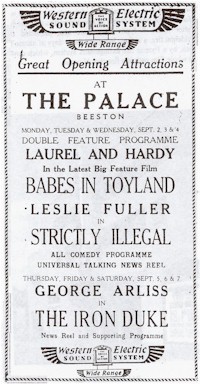 The grand re-opening was on 2nd September 1935 with an all comedy double feature programme with Laurel & Hardy on "Babes in Toyland" and Leslie Fuller in "Strictly Legal" complete with a Universal Talking Newsreel.
The grand re-opening was on 2nd September 1935 with an all comedy double feature programme with Laurel & Hardy on "Babes in Toyland" and Leslie Fuller in "Strictly Legal" complete with a Universal Talking Newsreel.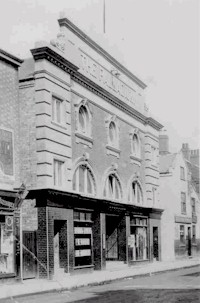
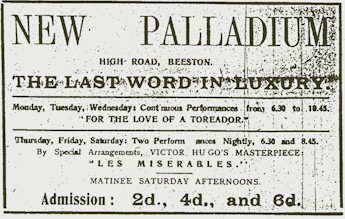 In the following week, large numbers filled the opening performances, eager to see what this new attraction had to offer and to watch the first week's programme - "For The Love of a Toreador"
followed later in that week by "Les Miserables". Seats were available at 2d, 4d and 6d (between about 1 to 2 pence) and Circle seats could be booked in advance for 9d.
In the following week, large numbers filled the opening performances, eager to see what this new attraction had to offer and to watch the first week's programme - "For The Love of a Toreador"
followed later in that week by "Les Miserables". Seats were available at 2d, 4d and 6d (between about 1 to 2 pence) and Circle seats could be booked in advance for 9d.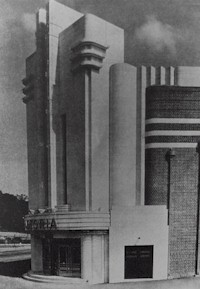
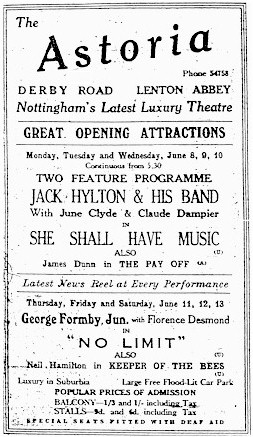 The Astoria opened on Monday, 8th June 1936 with a showing of "She Shall Have Music" staring Jack Hylton & His Band with June Clyde and Claude Dampier. The supporting film was "The Pay Off" and, of course, there was a newsreel. Seat prices in the stalls were 9d and 6d (about 2-4p) while
admission to the balcony was 1/3d and 1/- (about 5-6p). From the start there was a Saturday matinee for children which, at the begining, cost 3d.
The Astoria opened on Monday, 8th June 1936 with a showing of "She Shall Have Music" staring Jack Hylton & His Band with June Clyde and Claude Dampier. The supporting film was "The Pay Off" and, of course, there was a newsreel. Seat prices in the stalls were 9d and 6d (about 2-4p) while
admission to the balcony was 1/3d and 1/- (about 5-6p). From the start there was a Saturday matinee for children which, at the begining, cost 3d.
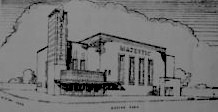
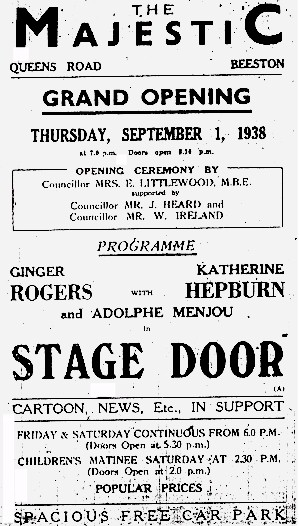 The cinema was declared open by Councillor Mrs E Littlewood M.B.E supported by other civic dignitaries, followed by a showing of "Stage Door" starring Ginger Rogers and Katherine Hepburn and there was a full supporting programme, including
a cartoon and newsreel. The cinemas was under the management of Jack Dodds who had previously managed the Berridge Road pictute house in Nottingham.
The cinema was declared open by Councillor Mrs E Littlewood M.B.E supported by other civic dignitaries, followed by a showing of "Stage Door" starring Ginger Rogers and Katherine Hepburn and there was a full supporting programme, including
a cartoon and newsreel. The cinemas was under the management of Jack Dodds who had previously managed the Berridge Road pictute house in Nottingham.